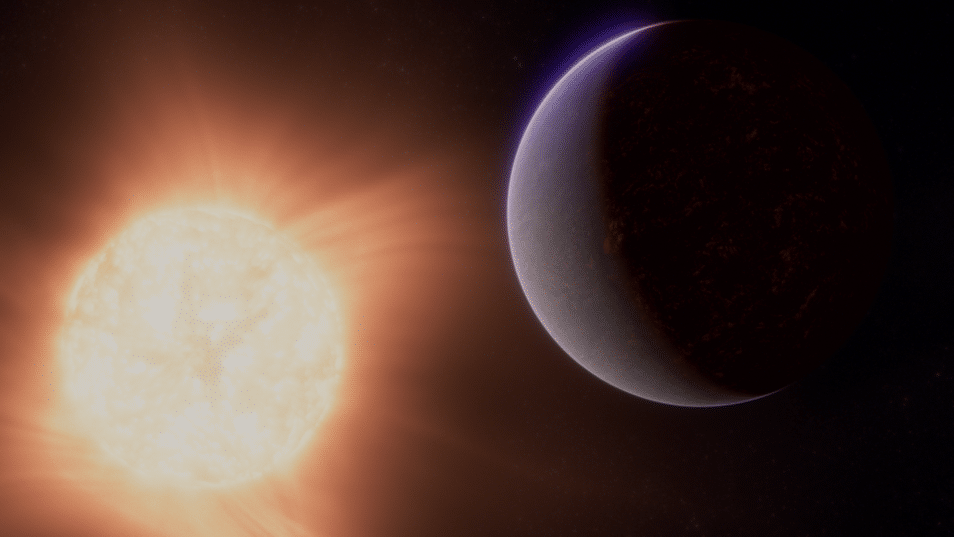After previously discovering atmospheres around dozens of giant gas planets outside our solar system, there is now, at last, fairly convincing evidence of an atmosphere around a rocky exoplanet: 55 Cancri e.
This was announced by an international team of researchers, including scientists from the Leiden Observatory and SRON. Their findings appear in the journal this week nature.
About 55 Cancri E
The research article is about 55 Kankri E. This planet is located about 41 light-years from Earth, and revolves with four other planets around the sun-like star Cancri. 55 Cancri e is roughly twice the size of Earth, but slightly denser than our planet. This means that the planet can be considered among the super-Earths. These planets are larger than Earth, but smaller than Neptune and are likely similar in composition to the rocky planets in our solar system.
Orbit closure
55 Cancri e is close to its parent star, which means it is very hot and likely has a molten surface. It is best to imagine this surface as an ocean of flowing magma. This close orbit may also ensure that the planet has a day side and a night side, with the day side always pointing toward the parent star and the night side always pointing away from the parent star.
Atmosphere?
55 Cancri e was actually discovered in 2011. Since then, researchers have also been wondering whether this exoplanet has an atmosphere. This is not self-evident, and certainly not when we consider the circumstances in which the 55 Cancri E finds itself; These don’t seem very useful right away for maintaining the atmosphere. Because, as mentioned earlier, 55 Cancri e is very close to its parent star, about 25 times closer than Mercury is to the Sun. As a result, the planet not only has a very high temperature, but is also constantly bombarded by radiation and solar wind from its parent star.
James Webb
But new measurements by the James Webb Telescope now strongly suggest that these conditions could not prevent 55 Cancri e from having an atmosphere. The researchers came to this conclusion after using James Webb to measure 4- to 12-micron infrared light coming from 55 Cancri e as the planet orbits its parent star. The researchers were particularly interested in the brightness when the planet was behind the parent star, and in fact, they only measured the brightness of the parent star. They then also measured the brightness when the planet was next to the parent star, or the brightness of the parent star and planet together. By subtracting the brightness measured when it was 55 Cancri e behind the parent star from the brightness measured when it was 55 Cancri e next to the parent star, the researchers were able to determine the amount of infrared light of different wavelengths coming from the day side of the parent star. Planet, calculate.
Thermal energy
The researchers found the first indication that 55 Cancri e had an atmosphere when they examined temperature measurements based on thermal energy, which is emitted in the form of infrared light. These revealed that the day side temperature is around 1540°C. This is a high temperature, but not as high as the researchers expected if 55 Cancri e did not have a (large) atmosphere. In this scenario, according to their calculations, the dayside temperature should reach 2,200 degrees Celsius. The fact that the temperature is lower on the day side indicates the existence of an atmosphere in which energy is distributed from the day side (hot) to the night side (cooler). The atmosphere is likely rich in volatile materials.
Carbon monoxide or carbon dioxide
Its existence is also supported by other measurements made by Webb. “We see evidence of a dip in the spectrum between 4 and 5 microns,” says researcher Aaron Bello-Aroff. “Less of this light reaches the telescope. This indicates the presence of an atmosphere containing carbon monoxide or carbon dioxide, which absorbs this light.”
The Spitzer Space Telescope has previously examined 55 Cancri e and specifically the question of whether this exoplanet has an atmosphere. Observations indicated the presence of a large atmosphere composed of volatile materials. But the Spitzer data can also be translated in another way. In this alternative scenario, 55 Cancri e was bare, except for a thin layer of evaporated rock – rich in elements such as silicon, iron, aluminum and calcium. Considering the circumstances in which 55 Cancri-E found itself, this was certainly not an unimaginable scenario; The planet is so hot that some of the molten rock on the surface is expected to evaporate. Webb’s new measurements are clearer in this regard. The noticeable dip in the spectrum between 4 and 5 microns cannot be seen on a planet with no atmosphere or an atmosphere composed only of vaporized rock. In other words, everything indicates that the 55 Cancri E has a real vibe.
It is suspected that 55 Cancri e was not born with this atmosphere, but more or less created it himself. This is because gases – possibly carbon monoxide and carbon dioxide – emerge from the planet’s interior. “Lava can store large amounts of water and carbon dioxide,” says researcher Christian van Bochem. “So we think that a lava ocean could act as a reservoir and continuously supply gas to the atmosphere.”

“Coffee buff. Twitter fanatic. Tv practitioner. Social media advocate. Pop culture ninja.”








More Stories
A biologist steps on snakes 40,000 times to look for bites
How healthy is celery?
Discovery of a giant volcano on Mars